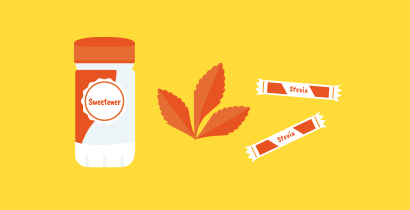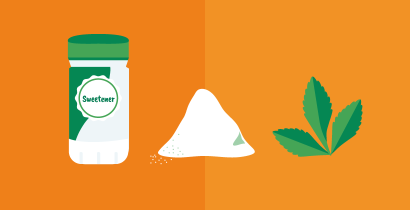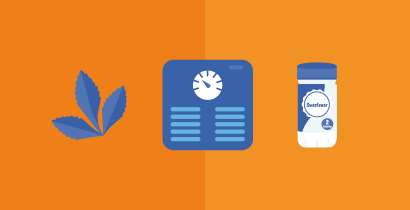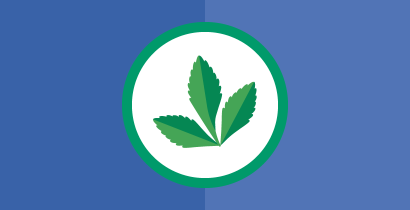Sweeteners: Addressing Common Questions and Debunking myths
Last Updated : 31 July 2024For centuries, various foods, like honey or sugar, have been used to sweeten our food. Today, we also have a range of new sweeteners, which provide low-calorie alternatives to sugar. The EU has established strict rules about which sweeteners may be safely used and what information must be included on labels to inform consumers.
What are sweeteners and what different kinds are there?
Sweeteners are ingredients added to food to replace sugar. Some sweeteners, often called “intense sweeteners”, provide an intense sweet taste without calories, or with very few calories (for examples see Table 1). Because they are intensively sweet, only very small amounts are needed. Another widely used group of sweeteners are called low-calorie sweeteners, bulk sweeteners or “polyols” (for examples see Table 1). These sweeteners provide fewer calories per gram than does sugar (saccharose) while having the same bulk (volume, see also the article on ‘Replacing sugars’). Rules for the use of both types of sweeteners are laid down in the European Commission regulation on food additives (2008)1, which covers “food additives, food enzymes, food flavourings and nutrients”. This directive does not apply to foods that have sweetening properties, like sugar, honey or maple syrup.
|
Intense Sweeteners |
Low-Calorie Sweeteners (Polyols) |
|
Acesulfame K |
Sorbitol |
|
Aspartame |
Mannitol |
|
Cyclamates, |
Isomalt |
|
Saccharin |
Maltitol |
|
Thaumatin |
Lactitol |
|
Neohesperidine DC |
Xylitol |
|
Steviol glycosides (from the stevia plant) |
|
Table 1. Types of intense and low-calorie sweeteners commonly used in foods.
Why and how do we use sweeteners?
Sweeteners are used as an alternative to sugar for a number of reasons. Low-calorie sweeteners may be used by people trying to lose weight or control their weight. As sweeteners do not promote tooth decay, they can be used to sweeten things like toothpaste and dental mouthwash. Sweeteners may play a role in contributing to the healthfulness of a diet without having to sacrifice the pleasure of eating sweet foods with some evidence in humans that low-calorie sweeteners can contribute to reduced energy intake and body weight under specific conditions (see also section on ‘Are sweeteners better than sugar?’ for the conditions)2,3. Finally, certain sweeteners have a technical use, aside from their sweetening effect. For example, polyols can be used to keep things like cakes and buns moist.
What is the difference between natural and artificial sweeteners?
Natural sweeteners are extracted from plant sources (e.g. stevia) or produced by animals (e.g. honey), whereas artificial sweeteners are manufactured through industrial processing. The structure of the sweetener chemicals differ between and within the natural and artificial types of sweeteners.
Natural sweeteners may provide some calories, whereas artificial sweeteners contain generally fewer calories per gram than sugar because they are not metabolised by the body in the same way as sugar. Examples of natural sweeteners include stevia (derived from the leaves of the Stevia rebaundiana plant) and erythitol (produced using fermentation or enzymatic processes, usually from glucose). Examples of artificial sweeteners include aspartame, sucralose, saccharin, and acesulfame K.
How are artificial sweeteners made?
Artificial sweeteners are industrially processed from naturally occurring compounds (such as amino acids, the building sources of proteins). The manufacturing process may include fermentation as well as synthetic chemical reactions. For example, aspartame is synthesized by combining the amino acids aspartic acid and phenylalanine, sucralose is made through a process that involves selectively chlorinating sucrose molecules, and acesulfame K is synthesized by chemically transforming acetoacetic acid.
Are sweeteners better than sugar?
There is no consensus from current scientific evidence on whether sweeteners are better than sugar. As sweeteners comprise many different compounds (e.g. aspartame, neotame), they cannot be considered as one group to be compared with sugars in general. Whereas science is clear that negative health outcomes are associated with excessive energy intake (particularly through the overconsumption of soft drinks), benefits of sweetener uses (such as weight loss) are likely dependent on the specific circumstances in which they are consumed: the type of sweetener, a person’s BMI, in what type of food the sweetener is used (solid or liquid), the duration of time over which a sweetener is consumed, whether there are pre-existing metabolic conditions, etc.2–5. Hence, to understand whether sweeteners are better than sugar, the specific situation a person is in will have to be assessed to understand whether there may be a benefit in replacing sugar with sweeteners.
Are sweeteners safe?
According to EU law, sweeteners (like other food additives) must be authorised before use and continuously re-evaluated for their safety (in accordance with the provisions of the European Commission regulation no 257/20106). Sweeteners used by food manufacturers are usually subject to certain conditions of use. That is, the law specifies to which foods authorised and approved sweeteners may be added, and the quantities. Assessment of sweeteners is the same as for all food additives and is based on reviews of available safety data. From the available data, a maximum level of an additive that has no demonstrable toxic effect is determined. This is called the 'no-observed-adverse-effect level' (NOAEL) and is used to determine the 'Acceptable Daily Intake' (ADI) figure for each food additive and that includes intense sweeteners. The ADI provides a large margin of safety and refers to the amount of a food additive that under normal circumstances can be taken daily in the diet, over a lifetime, without any health problem. In certain cases, such as the polyols, the law does not specify a maximum level (ADI “not specified”) but stipulates that it must be used in accordance with “good manufacturing practice”, sometimes referred to in technical specifications as “quantum satis”. Manufacturers must not use more than is necessary to achieve the intended purpose. In the case of sweeteners it is expected that daily intake even in people consuming high quantities of sweetener-sweetened products falls well below the presumed toxic threshold5,7 (i.e. scientists do not know what the toxic level in humans is, because only animal studies have been done using that specific sweetener, yet we have sufficient information from animal studies to understand how much people can ingest without any ill effects).
In order to ensure that consumers know which sweeteners have been used in the different food products, sweeteners must be labelled in a certain way. Sweeteners that can be bought in supermarkets must be labelled “…-based table-top sweetener”, where the blank is filled in by the name of the sweetener used. Foods containing intensive sweeteners are also required to state that fact on the label and to name the sweetener in the ingredients list. Polyol sweeteners must note their laxative effects, while those containing the intense sweetener aspartame should state that it is a source of phenylalanine, because people suffering from phenylketonuria cannot metabolise this amino acid.
How do sweeteners relate to our health?
From a scientific point of view, evidence on sweeteners and health effects in people indicates that sweeteners may contribute to decreased energy intake and body weight, as well as improved cardiometabolic risk factors 2,3,5,8–11. Further, polyols and intense sweeteners have been shown to prevent tooth decay9,12, and EFSA acknowledges that compared to table sugar sweeteners reduce blood sugar levels after eating12. However, whether lower blood sugar levels result in long-term health benefits, for instance, on diabetes, is not known as studies so far have come up with contradicting evidence7,12,13.
Finally, sweeteners may be added to non-food products to modify consumer behaviour (such as in tobacco) rather than for calorie reduction purposes14.
Do sweeteners make you fat?
Scientists currently do not know whether sweeteners cause weight gain. Indeed, most scientific evidence shows that sweeteners may have a role in weight management by reducing energy intake and body weight when used as a sugar replacement in the diet of adults, adolescents or children2,3,5,8,9,12,13,15–18.
There have been theories that use of sweeteners causes
• sweetness habituation (i.e. getting used to sweet taste),
• increased cravings for sweetened products, and
long-term metabolic health effects including impacts on genes through parental habits before conception. This may result in an increase in food intake and weight gain. However, these studies are not providing clear answers due to limited data available5,20,21. Another indirect way to gain weight may be through polyols which an effect on our gastro-intestinal health through the gut bacteria; however, it has yet to be clarified whether the impact on the gut microbiota is beneficial or detrimental for humans or even biologically relevant7,22.
The latest World Health Organization’s report on the use of non-sugar sweeteners recommended that non-sugar sweeteners should not be used to achieve weight control (or reduce the risk of non-communicable diseases) in people without diabetes23. However, this report had a few limitations:15
• The guidelines relied heavily on prospective cohort studies, which are generally ranked as having a lower certainty of evidence compared to RCTs as they cannot establish causality. Prospective cohort studies included in the WHO review showed that non-sugar sweetener intake was associated with increased body mass index (BMI), obesity, type 2 diabetes, cardiovascular disease, and all-cause and cardiovascular mortality, while RCTs showed that those consuming higher levels of non-sugar sweeteners had lower body weight and lower BMI than those who consumed lower amounts or no non-sugar sweeteners.
• The prospective cohort studies included in the review used methodologies with a high risk of bias. Such biases included reverse causality (i.e., being at high risk for obesity or chronic diseases leads to increased sweetener intake as an attempt to reduce disease risk. This makes it difficult to determine whether sweetener intake resulted in disease), incomplete adjustments for factors associated with non-sugar sweetener intake and disease risk, and behaviour clustering (i.e., individuals with a high non-sugar sweetener intake may also engage in other behaviours associated with healthy lifestyles, such as having higher quality diets and smoking less). Studies adjusting properly for these factors show that non-sugar sweetener intake contributes to weight and cardiometabolic benefits by reducing or displacing excess calories from sugar24.
The European Association for Study of Diabetes recommends the use of non-sugar sweeteners to replace sugars in beverages and foods as a risk reduction strategy for people with or at risk for diabetes25 i.
Do sweeteners cause cancer?
Scientific evidence and food safety agencies agree that sweeteners do not cause cancer. Despite calls from some experts for stronger, more long-term studies on the individual sweeteners2, the current scientific consensus is that there is no evidence that sweeteners cause cancer. Indeed, international food safety agencies such as the European Food Safety Agency (EFSA) and the US Food and Drug Administation (FDA) have investigated each market-authorized sweetener in detail and concluded that these sweeteners are safe for daily use. EFSA usually provides a maximum value for each authorised food additive (sweeteners are considered food additives) which is often well above the estimated intake of individual people to ensure both short-term and long-term toxicological safety.
So, what are official recommendations on sweeteners?
As sweeteners are food additives, there are no recommendations on their consumption in the same way as we have recommendations for other nutrients like carbohydrates, proteins or fats. However, with data on beneficial health effects of sweetener consumption being strongly dependent on context (e.g. your body weight, whether sweetener are used as replacement for sugar in solid or liquid foods, how long you replace sugar with sweeteners for, the type of sweeteners) , expert panels supporting public health authorities agree that 2,5,9,13,15,26,27:
- Sweeteners may be supportive in weight loss and weight management
- There is currently insufficient evidence for an intentional, large-scale replacement of sugars in sweet products
- Non-sugar sweetened drinks should not be used as a substitute for water
- Sweeteners may be acceptable for diabetics to manage their glycemia
- Gradually adjusting your taste preferences to less sweet tastes may be a useful strategy to support reducing sugar intake in the diet. Low calorie sweeteners can be an alternative supportive tool in this process.
References
- European Union Regulation (EC) No 1333/2008 of the European Parliament and of the Council of 16 December 2008 on food additives.
- Toews I, et al. (2019). Association between intake of non-sugar sweeteners and health outcomes: systematic review and meta-analyses of randomised and non-randomised controlled trials and observational studies. BMJ 364:k4718.
- Rogers PJ, et al. (2016). Does low-energy sweetener consumption affect energy intake and body weight? A systematic review, including meta-analyses, of the evidence from human and animal studies. International Journal of Obesity 40:381–394.
- Peters JC, et al. (2016). The effects of water and non-nutritive sweetened beverages on weight loss and weight maintenance: A randomized clinical trial. Obesity 24:297-304.
- ANSES (2016). Opinion of the French Agency for Food, Environmental and Occupational Health and Safety (ANSES) on the establishment of recommendations on sugar intake. Accessed 17 October 2019.
- Commission Regulation (EU) No 257/2010 of 25 March 2010 setting up a programme for the re-evaluation of approved food additives in accordance with Regulation (EC) No 1333/2008 of the European Parliament and of the Council on food additives.
- European Commission JRC Knowledge Gateway: Health Promotion and Disease Prevention. Accessed: 17 October 2019.
- Malik VS (2019). Non-sugar sweeteners and health. BMJ 364:k5005.
- Scientific Advisory Committee on Nutrition (2015). Carbohydrates and health. London, United Kingdom: Public Health England.
- Miller PE & Perez V (2014). Low-calorie sweeteners and body weight and composition: A meta-analysis of randomized controlled trials and prospective cohort studies. American Journal of Clinical Nutrition 100:765-777.
- Bellisle F (2015). Intense sweeteners, appetite for the sweet taste, and relationship to weight management. Current Obesity Reports 4:106-110.
- European Food Safety Authority (2011). Scientific opinion on the substantiation of health claims related to intense sweeteners and contribution to the maintenance or achievement of a normal body weight (ID 1136, 1444, 4299), reduction of post-prandial glyc
- US Dietary Guidelines Committee (2015). Scientific report of the 2015 Dietary Guidelines Advisory Committee. Washington D.C., USA: US Department of Agriculture.
- Jordt SE & Jabba S (2019). Sweeteners are added to modify consumer behaviour. BMJ 364:I366.
- Khan, T. A., Lee, J. J., Ayoub-Charette, S., Noronha, J. C., McGlynn, N., Chiavaroli, L., & Sievenpiper, J. L. (2023). WHO guideline on the use of non-sugar sweeteners: a need for reconsideration. European Journal of Clinical Nutrition, 77(11), 1009-10
- Kmietowicz Z (2019). Non-sugar sweeteners: lack of evidence that they help to control weight. BMJ 364:l7.
- Azad MB, et al. (2017). Nonnutritive sweeteners and cardiometabolic health: a systematic review and meta-analysis of randomized controlled trials and prospective cohort studies. Canadian Medical Association Journal 189:E929-E939.
- Romo-Romo A, et al. (2016). Effects of the non-nutritive sweeteners on glucose metabolism and appetite regulating hormones: Systematic review of observational prospective studies and clinical trials. PLoS One 11:e0161264.
- Public Health England. (2015). Sugar Reduction: The evidence for action. Annex 5: Food supply. London, UK: Public Health England.
- Gardner C, et al. (2012). Non-nutritive sweeteners: current use and health perspectives: A scientific statement from the American Heart Association and the American Diabetes Association. Circulation 126:509-519.
- Reid AE, et al. (2016). Early exposure to non-nutritive sweeteners and long-term metabolic Health: A systematic review. Pediatrics 137:e20153603.
- Spencer M et al. (2016). Artificial sweeteners: A systematic review and primer for gastroenterologists. Journal of Neurogastroenterology and Motility 22:168-80.
- World Health Organization (2023). Use of non-sugar sweeteners: WHO guideline. Geneva: World Health Organization. Licence: CC BY-NC-SA 3.0 IGO.
- Lee, J. J., Khan, T. A., McGlynn, N., Malik, V. S., Hill, J. O., Leiter, L. A., ... & Sievenpiper, J. L. (2022). Relation of change or substitution of low-and no-calorie sweetened beverages with cardiometabolic outcomes: a systematic review and meta-an
- Diabetes and Nutrition Study Group, & European Association for the Study of Diabetes (EASD. (2023). Evidence-based European recommendations for the dietary management of diabetes. Diabetologia, 66(6), 965-985.
- American Diabetes Association (2018). Lifestyle management: standards of medical care in diabetes. Diabetes Care 41:S38-S50.
- Public Health England (2016). Protecting and improving the nation’s health. London, UK: Public Health England.
- World Health Organization (2023). Use of non-sugar sweeteners: WHO guideline. Geneva: World Health Organization. Licence: CC BY-NC-SA 3.0 IGO.



